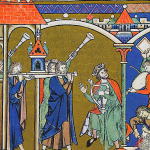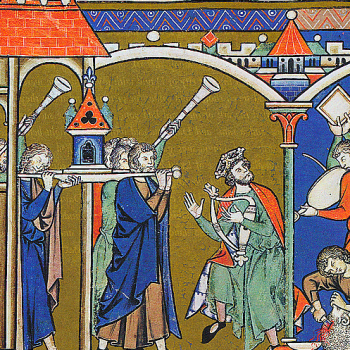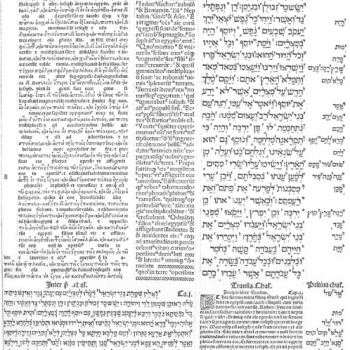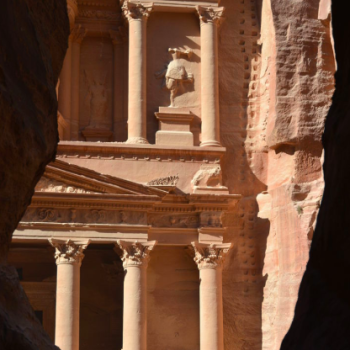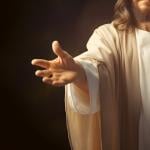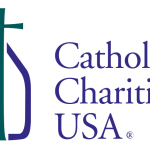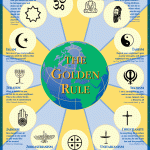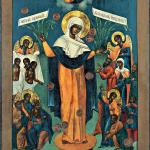This post is part of a series.
Part I: The Septuagint and the Masoretic Text
⇒ Part II: The Outline of the Hebrew Bible
Part III: The Biblical Centrality of the Temple
Part IV: The Blueprint of the New Testament (still to come)
Also: All of my content has always been free to read since I began this blog; however, in case you hadn’t come across it and would like to support me, I have a Patreon. I mention it because I’m coming up to a fairly serious financial pinch in about three weeks—if you’d be willing to sponsor me, even temporarily, that’d be really great. Thank you.
Pythagoreana
Okay, hang on. How are Daniel, Ezra-Nehemiah, and Chronicles the key to the rest of the Tanakh?
Because of their common focus. That focus is at its most explicit in Ezra-Nehemiah, but it is also central to the other two, far more than it may appear. Let’s discuss, beginning in the form of a lecture on numerology, or “Biblical sudoku” as they don’t call it.
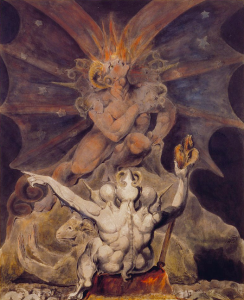
Don’t worry, we’re not going to be doing …
whatever’s going on here.
The Number of the Beast Is 666 (1805),
by William Blake.
As we established last time, there are twenty-four books in the Tanakh. The Tanakh has three sections, and twenty-four divided by three is eight, so we might expect it to fall into three groups of eight books; but it doesn’t. It’s instead divided in an irregular arrangement of a set of five, a set of eight (further subdivided into two sets of four), and a set of eleven (subdivided into a set of three, a set of five, and a set of three again).
That may sound very random. I don’t believe that it is. Five, four, and three have certain symbolic values. For example, all are divisors of sixty, the base of the sexagesimal mathematical system of Sumer. (There is more to be said for this system than you might suppose—it’s nice sometimes to have a mathematical system in which halves, thirds, quarters, fifths, sixths, tenths, and twelfths all play nicely.) Three may stand for creation, or the world as a whole, because it is the number of the realms of creation, i.e. earth, sea, and sky. It also represents time—past, present, future—and, therefore, fate. Four may stand for the world of human affairs: the edges of a map, the limbs of a body, the points of the compass,1 the Ninja Turtles, etc.
And five? Five was a mystical or magical number,2 sometimes associated with the planet Venus, a.k.a. the morning star and/or the evening star.3 Spatially, it represented a zenith above the earthly four: It was exhibited in the apex of a pyramid or a ziggurat, conceived as earthly structures that reached up into the heavens to afford a meeting place between humanity and the gods. Surely it could be no coincidence that, beneath the two greatest bodies in the heavens (the sun and moon), five wandering stars danced their way across the sky. Yet at the same time, five is a human number, exemplified in the five fingers we have on each hand and the five toes we have on each foot, or in our arrangement of five appendages protruding from the thorax (four limbs plus a head). If the supernal plane of the gods was a macrocosm higher even than the world we knew, and the individual person was the microcosm (as many esoteric traditions held and hold), primordially, the temple at the fifth point was the mesocosm, an intermediary world.
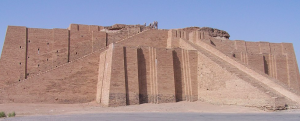
The reconstructed ziggurat of Ur, located in
southern Iraq. Photo by Wikimedia contrib-
utor Hardnfast, used under a CC BY-SA 3.0
license (source).
Likewise, there clearly ought to be perfect yearly cycle of three hundred sixty days—twelve months (three times four) of thirty days apiece (a “full” lunar cycle, rather than the “hollow” twenty-nine day cycle, which is obviously a mistake of some kind). Yet in fact, there are five additional days in the year—five gates through which eternity can enter time, suggesting the immeasurable, that which transcends and exceeds even a perfect circle. Five is thus a priestly number, representing exchange between earth and heaven.
Let’s glance back at the contents of the Tanakh:
TORAH: THE LAW OF MOSES, OR PENTATEUCH—First Set of Five
Genesis
Exodus
Leviticus
Numbers
Deuteronomy
NEVI’IM: THE FORMER PROPHETS—First Set of Four
Joshua
Judges
Samuel (I & II)
Kings (I & II)
NEVI’IM: THE LATTER PROPHETS—Second Set of Four
Isaiah
Jeremiah
Ezekiel
The Twelve Prophets
KETHUVIM: THE BOOKS OF TRUTH4—First Set of Three
Psalms
Proverbs
Job
KETHUVIM: THE FIVE SCROLLS, OR MEGILLOTH4—Second Set of Five
The Song of Songs
Ruth
Lamentations
Ecclesiastes
Esther
KETHUVIM: FINAL BOOKS—Second Set of Three
Daniel
Ezra-Nehemiah
Chronicles (I & II)
There are more minute divisions which can be made—the Five Books of the Psalms, for instance (I: 1-41, II: 42-72, III: 73-89, IV: 90-106, and V: 107-1505), or the four-five-three structure in which the Twelve Prophets can be read.6 But my main concern is up at this structural level, and I believe these sets of books parallel each other, number to number. I assume “the four Former Prophets match the four Latter Prophets” won’t be seen as too outlandish;7 what about the rest?
The Ten
Let’s start with the two sets of five (the Torah and the Scrolls, or Megilloth). These may not seem to reflect each other, but I think they do. Each one of the Scrolls displays a thematic resonance with the sequentially corresponding book of the Law.
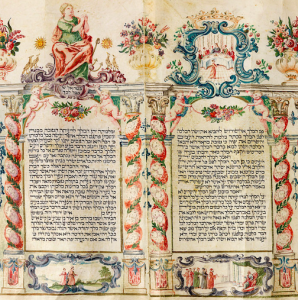
Decorated scroll of the Book of Esther,
created in Italy in the mid-18th c.
Currently located in the Israel Museum
in Jerusalem.
- The Song of Songs, a marital poem, echoes the creation of man and woman and the many crucial marriages in Genesis.
- Ruth, like Exodus, is about leaving idolatry behind and converting to Judaism: the Jews do it in Exodus; the title character does it in Ruth.
- Both Leviticus and Lamentations are about serving in the Temple and the ritual purity required to do so, albeit in extremely different ways. Leviticus is about these things directly, while Lamentations mourns the loss of the very possibility of these things (note its language, not only of ruin, but of pollution—”her filthiness is in her skirts”).
- Ecclesiastes, which is about impermanence (the word translated “meaningless” or “vanity” could better be rendered “insubstantial” or “ephemeral”), commemorates the forty years’ wandering recounted in Numbers.
- Deuteronomy is the part of the Law that warns the Israelites of the punishment of exile which will come upon them, if they are faithless to the covenant; Esther takes place in that exile, and shows God’s continued faithfulness to his covenant.
These sets of five also reflect each other in another way. Every week in synagogues, a Torah portion is read, going through the whole in a year’s time. Likewise, the Five Scrolls are so arranged because they have liturgical functions. The Song of Songs is read at Passover, the holiday of the Exodus; Ruth is associated with Pentecost, when the Israelites reached Mount Sinai and first received the Law; Lamentations is read for Tisha b’Av (“the Ninth of Av”),8 commemorating the destruction of the Temple; Ecclesiastes is read during the feast of Sukkot; and Esther, naturally, is read on Purim (the holiday whose origin it recounts). Thus, the Pentateuch and the Megilloth both point to the liturgy as the proper meeting place between mankind and God—and in the Tanakh, the Temple is the heart of all liturgy.
NOTE: When I initially published this post a couple days ago, I completely failed to make my intended point in my first mention of Ecclesiastes, and also got some of the links explaining the Jewish holidays mixed up; I also garbled a sentence in a paragraph in the section below, the one right before the closing quotation from Exodus. These errors have now been corrected!
Sons of the Prophets
This is not just a feature of these ten books. It’s reinforced everywhere in the Tanakh. It is first of all central to the Torah: After the general background of Genesis, recollect how Moses originally haggled with Pharaoh: “Let my people go, that they may hold a feast unto me in the wilderness”; in other words, the chosen people are chosen for the purpose of worship. Once the Exodus is effected, we see the description and construction of the Tabernacle and all its furnishings, crowned by the descent of the divine Presence into it—a partial reversal of the rift opened between man and God in Eden. God is still hidden (“you shall not see my face, for there shall no man see me and live”), yet he is hidden among mankind.
Next comes a kind of commentary upon the Torah in the Prophets, Former and Latter. The Former Prophets often confuse people, because we tend think of “the prophets” as beginning with Elijah; but the reality is, the Israelites were always guided by prophets. They might fulfill other roles at the same time; many do in the Bible—judge, king, scribe, general, priest. But Joshua, Shamgar, Deborah, Gideon, Samuel, David, and good old Iddo the Seer all fit the profile, and all are earlier than Elijah.
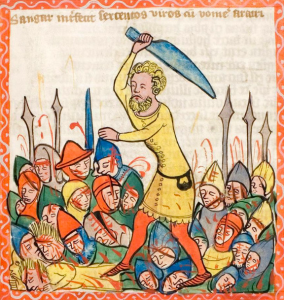
My boy, Shamgar ben Anath (who of the
Philistines slew six hundred men with an
ox goad, and also delivered Israel, since
he was up anyway).
The impression that prophets are a later development is partly due to a more important error, one about what prophecy was even for. The primary role of the prophet was not predicting the future. Prophets might receive that gift, to attest the validity of their prophetic vocation; but it wasn’t a superpower available at their discretion, and it was not what made them prophets. Rather, the prophet’s role lay in explaining and applying the Torah. When I was in grade school, a classmate of mine described this as the difference between prophetic foretelling and forth-telling, as in “tell forth the word of the Lord.” This is crucial to the guidance of the covenant people. The construction of the Temple is a good example: It is on prophetic say-so that David refrains from it, and on the same that Solomon goes ahead with it. The prophets must institute, authorize, and maintain the edifice that the priests use.
This in itself points back to the templar function of the people of Israel—this is why they were always guided by prophets. Remember what Moses was haggling with Pharaoh for in the first place? It was not simply a demand for liberation from slavery; it was to be allowed to go into the wilderness to sacrifice to the Lord. The Tabernacle and the Temple were their charge, but more ancient still was the memory of God speaking with Moses “face to face, as a man speaks to his friend,” and the hope encoded in the name Immanuel. The universal priesthood is sometimes alluded to as if it were a specifically Christian (or indeed, a specifically Protestant) doctrine, but it is as old as the Torah. Before any mention has been made of the Tabernacle, God tells Moses,
Thus shalt thou say to the house of Jacob, and tell the children of Israel; ye have seen what I did unto the Egyptians, and how I bare you on eagles’ wings, and brought you unto myself. Now therefore, if ye will obey my voice indeed, and keep my covenant, then ye shall be a peculiar treasure unto me above all people: for all the earth is mine: And ye shall be unto me a kingdom of priests, and an holy nation. These are the words which thou shalt speak unto the children of Israel.
—Exodus 19:3b-6
This post is part of a series.
Part I: The Septuagint and the Masoretic Text
⇒ Part II: The Outline of the Hebrew Bible
Part III: The Biblical Centrality of the Temple
Part IV: The Blueprint of the New Testament (still to come)
Footnotes
1Not that ancient Sumer had compasses, but four-point orientation was familiar, because it is built into the human body. Unless obstructed, we have freedom of movement in four of the six basic directions of three-dimensional space—forward, backward, left, and right. (We lack the capacity for more than a few feet of upward movement without the aid of a simple machine, namely the inclined plane; moreover, while downward movement through open space is easily begun, this is not freedom of movement, as we cannot control our speed or steer.) Forward, backward, left, and right are much older ideas than east, west, north, and south, and in some languages the latter are never fully distinguished from the former. There are faint traces of this in English: e.g., even though we habitually find directions relative to north, we still call this “orientation,” or finding the orient, the east—a more usual “chief” point of the compass before the discovery of magnetism.
2I’m drawing strongly on Joseph Campbell’s Primitive Mythology for this paragraph—it would honestly never have occurred to me to assign any great significance to the number five.
3For our purposes it isn’t really important why Venus is associated with the number five, but the short version is that, when viewed geocentrically, Venus’s orbit traces the shape of a five-petaled flower. This is known as the pentagram of Venus, and may be why the flower most associated with love is the rose, whose petals always come in multiples of five (except for the silky rose and the winged thorn rose, species found mainly in southern China). Incidentally, the planet Jupiter is also associated with a sacred number: Its orbit takes very nearly twelve terrestrial years—which, by a curious coincidence, is why the Chinese zodiac follows a pattern of twelve years instead of twelve months.
4These names for these two sets of books come from Hebrew. סִפְרֵי אֶמֶת [Sifrêy ‘Emeth], “books of truth,” comes from the fact that the initials of Job, Proverbs, and Psalms are ‘-m-t, and since Hebrew doesn’t write vowels by default, this spells ’emeth, “truth.” “Five scrolls,” חָמֵשׁ מְגִלּוֹת [Châmêsh M’ghillouth], will be explained momentarily.
5If you’re using a Bible with the Septuagint numbering of the Psalms, the five books are instead I: 1-40, II: 41-71, III: 72-88, IV: 89-105, V: 106-150. The Septuagint fuses Psalms 9-10 (⇒ 9) and 114-115 (⇒ 113), and splits Psalms 116 and 147 into two each (116:1-9 and 116:10-19 ⇒ 114 and 115; 147:1-11 and 147:12-29 ⇒ 146 and 147).
6To be specific: The first four (Hosea, Joel, Amos, and Obadiah) proclaim a mixed message, warning of judgment against wickedness but holding out the hope of blessing for the obedient. The next five (Jonah, Micah, Nahum, Habakkuk, and Zephaniah) are principally concerned with the conquests, first of Israel, then Judah, and finally of Assyria itself, which by the time of their prophecies are inevitable. Finally, the remaining three (Haggai, Zechariah, and Malachi) prophesy during the construction of the Second Temple.
7That said, there is a certain asymmetry in them. The natural apposition is not, as sequential order would suggest, between Kings and the Twelve; rather, it is between the Book of the Twelve and the Book of Judges—which has twelve judges, half of whom (Tola, Jair, Ibzan, Elon, Abdon, and especially my boy Shamgar) seem to have been dragged in by the heels for the sake of the numerical symbolism. There’s also a delicious irony in the recurring phrase from Judges, that “In those days Israel had no king; every man did what was right in his own eyes,” set in apposition to the willful and erratic conduct of the assorted monarchs of Judah and Israel. For the remainder, if we view the books of Joshua, Samuel, and Kings as defined by the prophetic callings of Joshua, Samuel, and David (who was a prophet as the author of the Psalms, at least conceptually), this then makes those three parallel to Isaiah, Jeremiah, and Ezekiel. This itself takes Samuel’s role in instituting the monarchy, which you’ll remember was originally characterized as a sort of apostasy on the part of the Israelites, and places it beside Jeremiah, the prophet in whose age both the throne and the altar were destroyed.
8Av is the eleventh month in the Hebrew calendar (measuring from Rosh ha-Shanah rather than Passover), and corresponds more closely to August than any other month on our calendar (though it often begins in mid-to-late July and lasts only thirty days).



